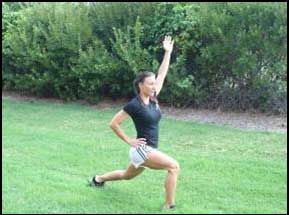Judging from the positive response to October’s column regarding station-friendly stretching, I thought it best to go with the flow in order to appease the audience. This month, assuming that everyone has been practicing their daily stretches, we will delve further into the issue by looking at active stretching.
Static stretching, which I covered last month, involves holding a position for a specific amount of time in order to elicit relaxation and subsequent elongation of muscle fibers and soft tissue. Consistent daily static stretching will help prevent injury, lessen the effects of postural strain/distortion, and help you to feel and move better.
Active, or functional, stretching achieves the same goal as static stretching except with one major difference — they are performed through a “functional” range of motion, one that is specific to a joint or natural movement in the body. Research has proven that active stretching is superior to static stretching prior to strenuous physical activity, with static stretching decreasing muscular force production in areas where active stretching does not. Active stretching has also been shown to better increase tissue temperature, which may have an effect on injury prevention — the warmer the joint and surrounding tissue, the less chance there is for injury.
It appears that within public safety, the mid-shift or in-between a call is the most opportune time to apply active stretching. One of the major benefits of active stretching is that most of them are done while standing and there are no long hold times. As the stretching involves movement, there is some slight calorie-burning. Active stretching is best done prior to beginning your workout, due to its inherent capacity to increase flexibility, raise tissue temperature and bring a joint through its full range of motion. The increase in heart rate and need to engage stability muscles while performing the active stretching truly makes it a functional warm up.
As a result, there is little need to perform static stretching prior to your workout, unless you have an ongoing injury, which is best addressed with a slow and gradual stretch. Save the static stretching for after the workout, when your body is in need of recovery and elongation of fatigued tissue.
Performing active stretching is simple as long as you adhere to a few principles:
- Never swing through the movement. They are fast, but need to be done with purpose.
- Certain movements require balance and flexibility. You may not be able to perform all of these movements safely; never force them.
- If you have an injury or any kind of muscle “problem,” perform static stretching for a few weeks prior to beginning active stretching.
- Many of the active stretches require a significant amount of strength and stability. If you are just beginning in fitness, make sure you start out slowly. Some stretches are no problem to accomplish, while others may be initially out of reach.
The active stretches included are only a few of the many you can and should perform; there are endless combinations that are applicable to sport and life. Active stretching is great while on duty due to its ease of integration. Hopefully, the psychology behind functional stretching will help you as well. As it feels like a workout, you may be more inclined to implement them prior to beginning your normal routine.
| Walking Lunge | ||||
Preparation Movement Tips Progression | ||||
| Inch Worm | ||||
Preparation Movement Tips
| ||||
| Frankenstein Walks | ||||
Preparation Movement Tips
| ||||

















